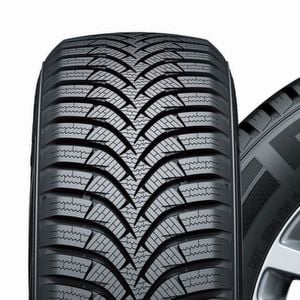Last Updated on 24.08.2023 by hrushetskyy
When buying tires, you should look for the following things:
- Tire code.
- DOT code.
- UTQG code.
- The type of tire.
- Fuel economy.
- Warranty.
- Noise.
Besides that, you should consider the following things:
- Manufacturer’s placard information.
- Whether to buy a new model or the same tire you currently have.
- What your needs are.
- Whether to buy a new or used tire.
Buying Tires Check List: Things to Look for in a Tire
Tire Code
Before buying tires, it’s vital that you check the tire code; as it contains info about the main specs, such as load and speed ratings, rim diameter, etc.
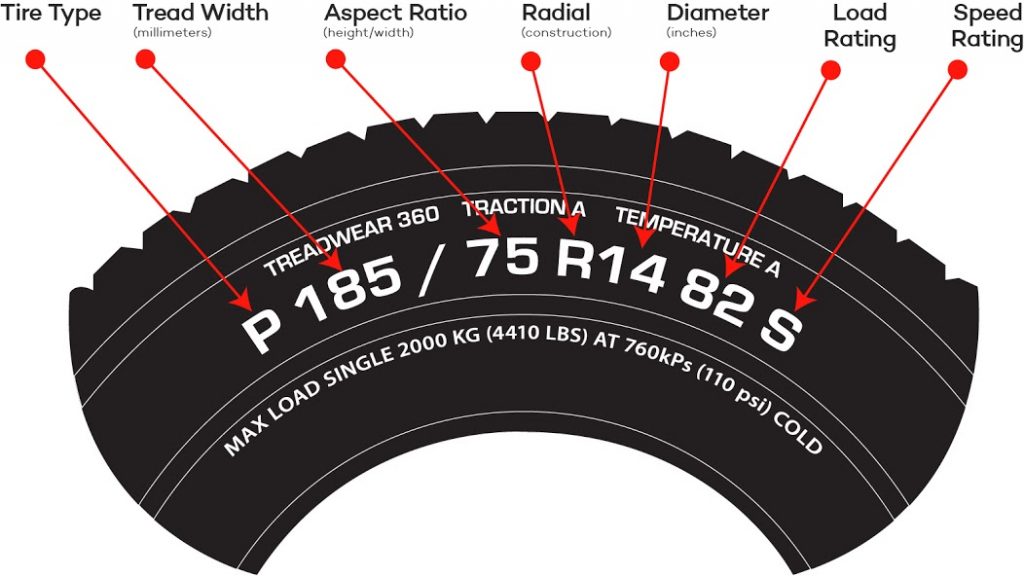
- Tire type.
The first letter of the code may be:- P for Passenger tires – regular tires fit most passenger cars.
- LT for Light Truck – tires with enhanced load-carrying capacities.
- ST for Special Trailer – tires with thicker sidewalls for larger vertical loads.
- T for Temporary – spare tires.
- Thread width.
This three-digit number represents the distance between sidewall edges in millimeters. - Aspect ratio.
The aspect ratio follows a slash and indicates the relation of section height to section width. For example, aspect ratio 65 means that the section height is 65% of the section width. The lower the ratio is, the better the steering of the tire will be. - Internal construction.
You may see:- R for Radial (the newest construction which has become widespread for the last 25 years; steel, nylon cords, or cords of other origins are placed under the tread in a radial pattern).
- B for Bias-Belt (a transition from bias-ply tires providing a smoother ride due to the belt-like layer under the tread).
- “–” for Bias-ply (cords are placed diagonally under the tread, providing a rather rough ride).
On some tires you may also see D for Diagonal, which is the same as bias-ply.
- Rim diameter.
A one- or two-digit number expressed in inches identifies the diameter of the wheel the tire is designed to work the best on. - Load rating (index).
A two- or three-digit number will show how much weight the tire can hold. Be aware that the index is introduced for one tire only – to get the full number, multiply it by four. You may see numbers from 60 (250 kg or 550 lb) to 139 (2,435 kg or 5,357 lb).
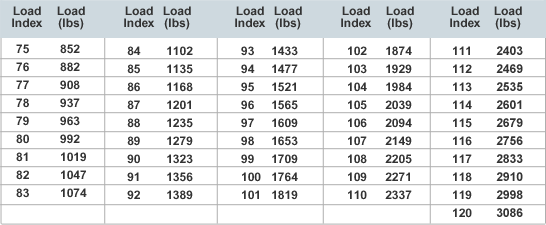
It’s important that when buying tires, you don’t choose one with a lower load index than specified in the recommendations.
- Speed rating (index).
This is a letter that indicates to what speed the tire dissipates heat efficiently. The more heated the rubber is, the faster it wears. And if you exceed the fixed maximum your tire has, you risk tire failure.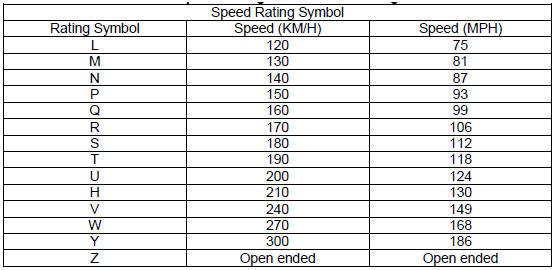
Speed rating chart. Image source: www.free-ed.net The most common rates are T (118 mph or 189.9 km/h) and H (130 mph or 209.2 km/h). These will be the most suitable for you if you travel for long distances on highways. However, if you aren’t a traveler, the S (112 mph or 180.2 km/h) rating may be enough for you.
There are different variations of tire code indexes, and every number and letter has to be considered and checked with the manufacturer’s manual.
DOT Code
DOT stands for the US Department of Transportation and its code is usually a combination of 10-13 digits and letters.
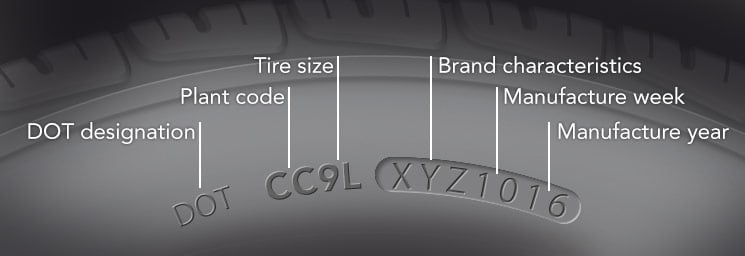
- Plant code.
Every manufacturer’s plant in every country has its own 2-3-symbol code. Tire Safety Group provides a database with all plant codes available, so you could check this information. - Tire size.
The two following symbols show tire size. However, this code translation isn’t for customers. It concerns manufacturers, and is mostly molded for them. These codes make it easier for them to find tires that have to be recalled. There is a document by the Rubber Manufacturers Association that is updated every now and then. However, it shouldn’t be considered as the main manual, as it isn’t full and not all manufacturers use this system. - Manufacturer identity number.
This 3-4-symbol code is molded solely for manufacturers’ purposes: they identify a tire by this code and recall it if necessary. - Date code.
The main thing for the driver is the tire’s 4-digit date code. The first pair of numbers means the week of manufacture, and the second pair indicates the year. In our case, the tire was made during the 39th week of 2009. To learn more about reading date codes before buying tires, read this article.
The date code is vital for any driver, as it says precisely how old the tire is. A tire lasts for a maximum of 10 years, no matter whether it’s ridden or stored in your garage/a store. Most manufacturers recommend buying tires once your old set turns 6 years old.
UTQG code
The UTQG code shows estimates of 3 tire characteristics based on the tests conducted by a particular manufacturer.
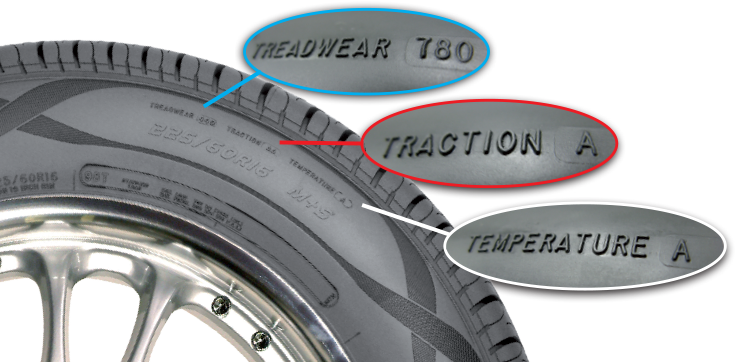
- Treadwear.
This rating is a 3-digit code, where 100 is standard wear, 200 – twice as much, etc. This is an estimate that is based on the tests run by the respective manufacturers. In extreme conditions or improper maintenance, the index may become irrelevant. - Traction.
This quality is evaluated in letters: AA, A, B, C, from the best to the worst. Traction test assesses stopping a vehicle on wet asphalt and concrete, measuring the coefficient in g (g-force). - Temperature resistance.
This characteristic is also measured in letters: A, B, C. It shows up to what speed a tire can safely dissipate heat, and is measured in mph. A goes for over 115 mph, B – 100-115 mph, and C – 85-100 mph.
The Uniform Tire Quality Grade code isn’t required for tires less than 12” in diameter, spare, winter, and deep-tread LT tires. All other tires that are sold in the US are required to be coded.
The Type of Tire
The most common tire types are:
- All-season.
These are the most common tires of 14-18” sizes that provide a driver with an all-year grip, comfort, and a long lifespan. They can go 40,000-100,000 miles and usually have speed ratings of S (112mph) and T (118 mph). - Performance all-season.
These tires will provide you with a whole-year traction and improved handling. They have speed ratings of H (130 mph) and V (149 mph) and a mileage of 40,000-80,000. Their sizes usually vary from 15 to 20 inches. - Ultra-high performance.
There are all-season and summer (three-season) UHP tires. The first type will give up some wet and dry traction to perform better in snowy conditions. The second has improved grip on wet and dry surfaces and none on snow and ice. Among the drawbacks, there are fast wearing and harsh rides – consider this when buying tires. Their speed ratings are ZR (above 149 mph), W (168 mph), and Y (186 mph). Their mileage is usually 30,000-60,000 miles. The common sizes are 17-22 inches. - All-season truck tires.
These tires are manufactured to withstand exceed loads, suitable for SUVs and pickups. Other characteristics like grip and wear are within adequate parameters. The speed ratings are usually S (112 mph), T (118 mph), and H (130 mph). The mileage can go from 40,000 to 80,000 miles, and the sizes vary from 15 to 22 inches. - All-terrain truck tires.
Such tires are designed for heavy duties and applications. Think of buying tires like these if your car is frequently ridden with high loads. They work well both on paved roads and off-road, providing adequate traction on all surfaces, including snow. The speed rating is usually S (112 mph), the mileage is 50,000-60,000 miles, and the sizes can be from 15 to 20 inches. - Winter/snow tires.
Winter or snow tires provide you with amazing grip, braking, and cornering on snowy and icy surfaces. The rubber keeps pliability in extremely cold temperatures, but it wears faster and brakes slower on clean roads. Speed ratings for these tires start at Q (99 mph), there’s no precise mileage guarantees. The sizes are quite diverse, going from 14 to 22 inches, so buying tires like these shouldn’t be a trouble. - Performance winter/snow tires.
Such tires come in 4 sizes to fit the cars that use UHP tires during all other seasons. They offer better grip on icy and snowy roads, with speed ratings starting at H (139 mph). As with regular winter tires, these also have no stable mileage. - Truck winter/snow tires.
As suggested by the name, best winter tires are manufactured specially for SUVs and pickup trucks. Their speed rating is usually S (112 mph), there’s no guarantee of certain mileage, and size range is 15-20 inches.

Fuel Economy
Bridgestone Firestone North America reports that buying tires of different types can show a difference of 15-20% in fuel usage.
Some things you can do to determine which tire will provide the best fuel economy:
- Look for tires with low rolling resistance.
- One of the best options for fuel saving on your particular vehicle is the original equipment tire.
- Check the tire’s specs for fuel efficiency grade – dome manufacturers provide this information.
There were attempts to implement a law that would demand fuel economy rates molded on tire sidewalls. However, it’s difficult to create standards, as not all the drivers know their tires can affect fuel usage.
Warranty
There are two types of warranty a tire manufacturer can provide you with: defect protection and tread warranty. The most popular world-class manufacturers usually provide both, offering a guarantee that the tread will last for several years.
However, think twice before purchasing a warranty. They are provided on a particular number of miles, and it often happens that the tire wears out faster. In such a case, there’s a possibility that you will get a replacement. However, most manufacturers will thoroughly check whether you have been taking good care of your tire(s). They will check whether you rotated them every 5,000-7,000 miles, whether they were properly inflated all the time, etc. So it’s not a given that you will eventually get the service you paid for.
Noise
When buying tires, choose less noisy models. When you’re driving in the city on low speeds, this factor doesn’t make much difference. However, you may want your car to be as quiet as possible when you drive on a highway, especially if you have an SUV.
All tires make some noise due to air flowing through the tread, but you can choose a quieter one. Treads of the same type can also differ in the level of noise, so it’s better to consult a shop assistant before buying tires.
Things to Consider Before Buying Tires
Such placards include recommendations on the tire choice according to the size, speed and load capacity, steering, on- and off-road specifications, etc. of your particular vehicle. Buying tires that are bigger or smaller in size or aspect ratio can change:
- The vehicle’s condition.
Tires keep your vehicle over the ground, so mounting a tire that is smaller in size will put more pressure on the rubber and increase the risk of crashing the car. Both bigger and smaller tires may need new wheels to operate well. - The speedometer reading.
The reading of your car’s speedometer usually depends on a full rotation cycle of the tire. When you change the size of your tire, you change the length of one circle. And considering that such speedometers are manufactured for a particular rotation length, increasing or decreasing it will provide you with wrong readings. - The automatic transmission shifts change time.
Buying tires of a different size will give your wheels different rotation and speed, so smaller tires will have to rotate more to achieve the speed you need. And considering that your transmission shifts according to the speed, the shifting time may change. Aside from that, there may be an impact on your fuel consumption and uphill/downhill shifts.
It’s possible to change tire size while avoiding these problems, but you should still consult your manufacturer agent. Also, you will need to keep the load of your car within the established parameters and adjust your transmission and speedometer.
If you don’t have your vehicle manufacturer’s manual, the same information can be found on the car. You can find it at the door edge, glove compartment door, trunk lid, or door port.
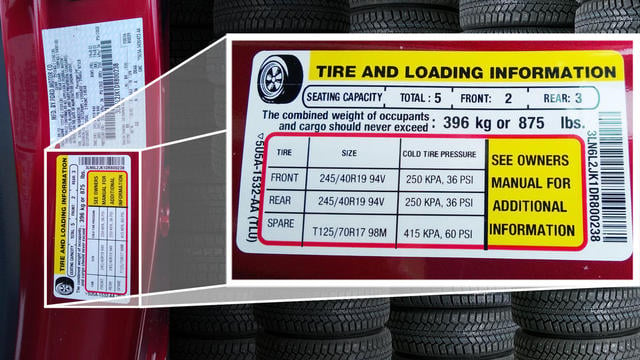
If you bought a used car and the information is painted over, you can find it on the manufacturer’s website or third-party services.
Current Vs. New Tire Model
Same Model
If you are satisfied with your current tires, the choice shouldn’t be a problem. If you’re still using your original equipment tires, note that they are made to perfectly match your vehicle and show all its benefits. If you notice your tires have bad grip and slip on wet surfaces, recall whether you had such problems when you bought them. If yes, you may need to try something new; if no, your tires are just old and/or worn out.
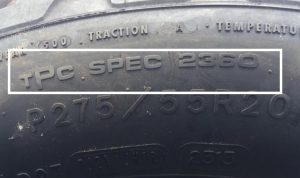
When buying tires that were on your car originally, expect the price to be pretty high. However, car manufacturers usually pair every vehicle with at least two different brands to match any driver’s budget. If there’s no information about this fact in your information placard, you can find the necessary alternative on websites that sell tires. There you will have to insert some information about your car to see the tires marked with OE (original equipment).
You can also find exact tires by knowing the code, which is different for many vehicle manufacturers. For General Motors it’s a TPC Spec code; for Porsche it’s N and numbers; for Mercedes – MO, MO1, or MOE, etc.
New Model
If you aren’t fully satisfied with the current tires, determine the issue and search for tires that meet your needs.
There is a trend on low-profile tires and larger wheels, but many people complain about the harshness of their ride. In such a case, picking touring or grand-touring tires instead of high- and ultra-high performance ones will make driving softer.
If you want more performance from tires in summer and don’t mind sacrificing your comfort a bit, buy summer tires instead of all-season ones. They will provide you with excellent grip on dry and wet surfaces, but no traction in snowy weather.
Make sure you do your research by reading about different brands of tires, their benefits, drawbacks, and pricing. Also, read reviews on official and independent services to be prepared for what you will see in a store. And if you aren’t sure whether it’s even time to buy new tires, find out how often you should purchase new rubber for your car.
Your Needs
When buying tires, analyze your needs:
- Driving style.
Determine what you need from your tire.- If you need comfort and good response, choose touring tires. They will provide you with a soft ride and good grip on dry and wet surfaces.
- If you need performance for your sports car, buy high performance tires. They will provide you with good traction on dry and wet surfaces at higher speeds.
- Road.
Do you drive more on highways or off-road?- If you drive a lot off the road and own a SUV or a pickup truck, consider off-road (all-terrain) or light-truck tires. They will provide you with sufficient grip on uneven surfaces.
- If you own a SUV or a pickup but drive on the road, think of SUV tires. They will provide you with a comfortable on-road application of your car.
- If you own a regular passenger or sports vehicle, think about touring or high performance tires.
- Regular load.
If you drive a lot with large loads on your vehicle, consider getting tires with a higher load index. If you own a SUV or a pickup truck and/or have a loaded trailer, consider buying tires of LT (light-truck) or ST (special trailer) type. LT tires will withstand extended loads and carry them in off-road conditions. ST tires are designed especially for trailers: their sidewalls are thicker so they can carry more vertical load. - The number of tires you need.
If you just need one or a pair, don’t buy the whole set, as the other tires may age and deteriorate by the time you will need them.
New or Used
New
Why buy new tires:
- They will provide you with 100% tread.
- There will be no patches and repairs.
- There will be no external and internal damages that may lead to an accident.
- New tires have warranty and you are notified if the tire is recalled.
Read more information on why you may want to buy new tires here.
Used
Why buy used tires:
- By buying used tires you get up to 90% of tread for 50% price.
- Used tires can be in quite good condition, as some of them are taken off new cars after a couple hundred miles.
- You can help the environment by buying tires that were used, as otherwise they may end up in landfills.
Find some more information on why you may want to buy used tires here.
Choose Tires Carefully
Your tire choice determines the quality of your ride, as well as the speed and load of your vehicle. It also indicates whether you have wasted your money on nothing or the tire will serve you for years. If your tire choice is wrong, it can also jeopardize yourself and your car. The wrong size can become troublesome for your vehicle functions, and tire age can cause tire failure. So, make sure you have a serious attitude towards choosing the best tires for your vehicle when you go to a tire shop.
Finally, don’t wait until spring to buy tires, as their traction ability differs on different surfaces when they wear a bit. Grip increases on dry surfaces due to more contact patch exposure, meaning more tread touches the ground. However, as the tire wears, grip decreases on wet and snowy surfaces due to the inability of tread to dissipate water and “bite” into the snow. So, buying tires in spring will leave you with less tread in winter, which is when you need the most grip.
Share the Knowledge
